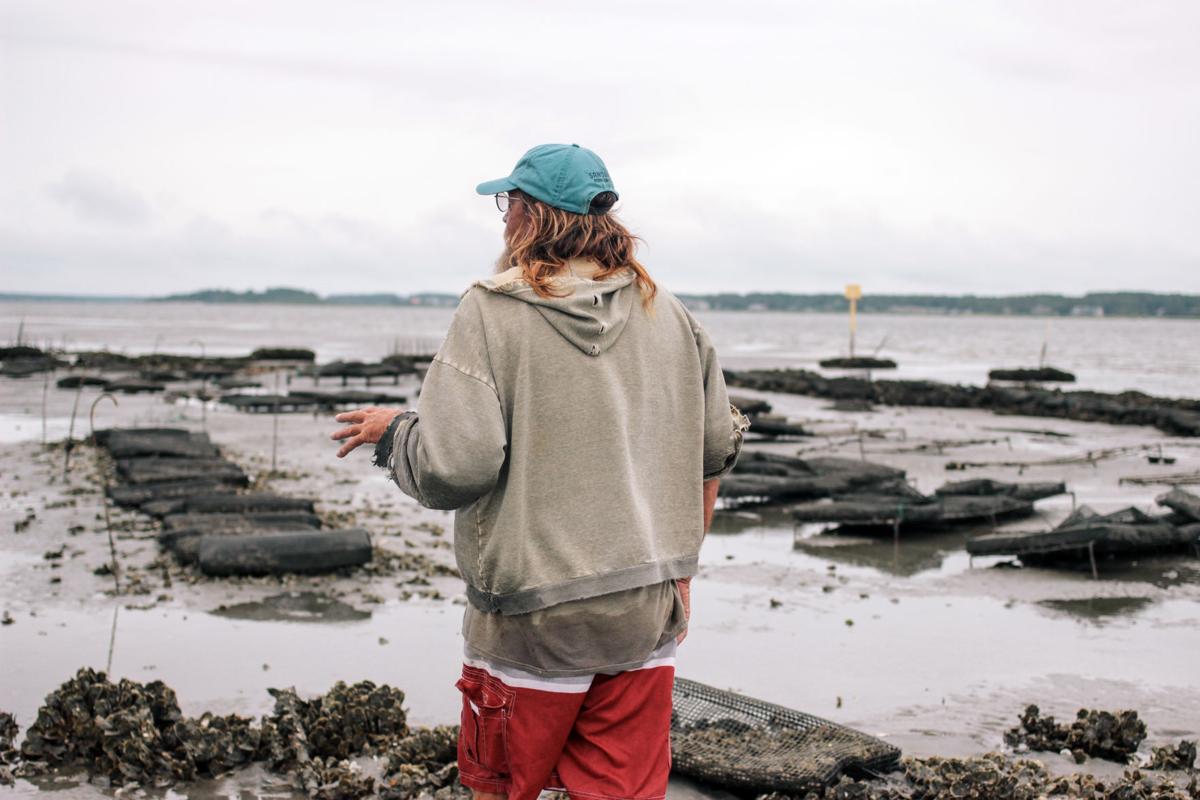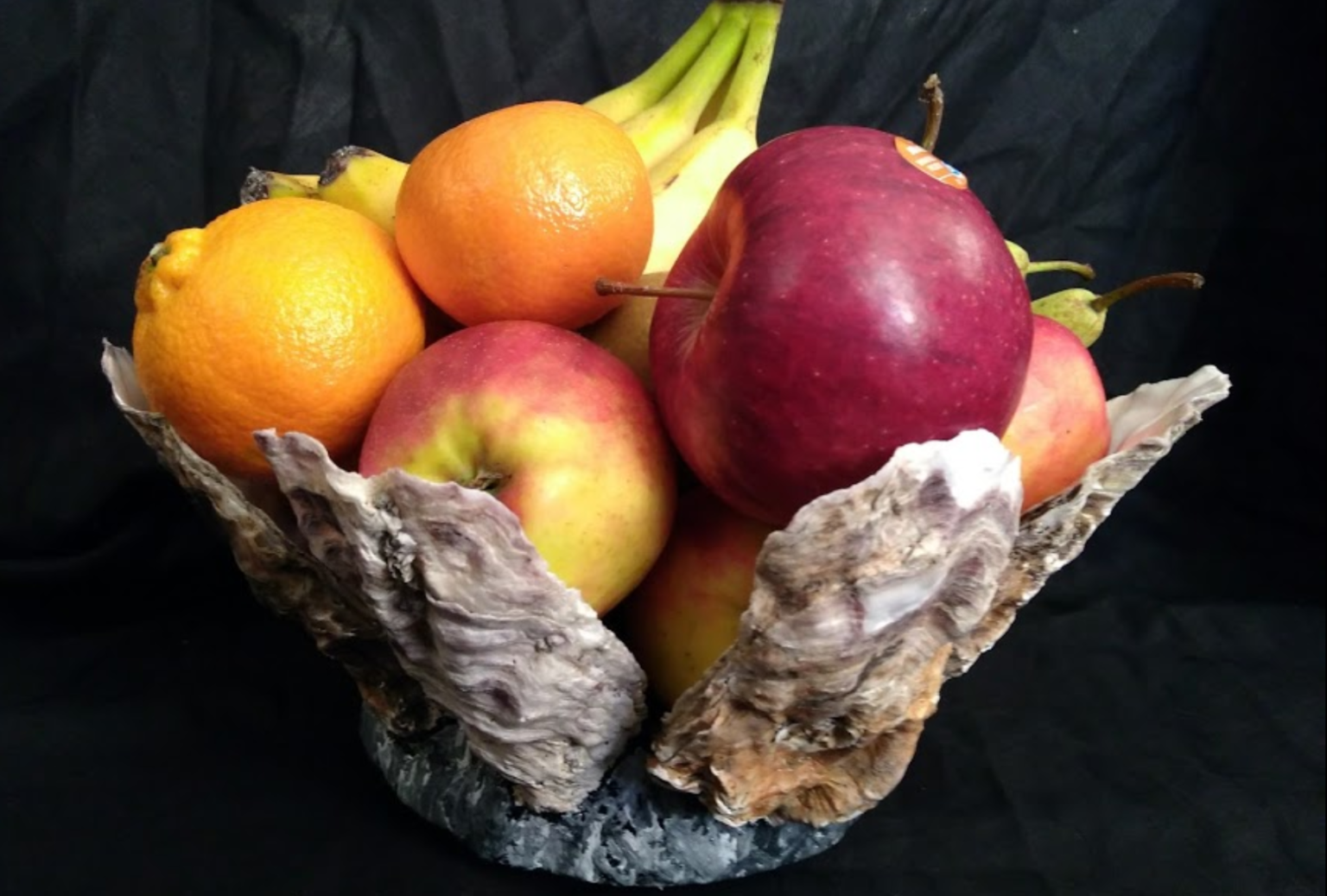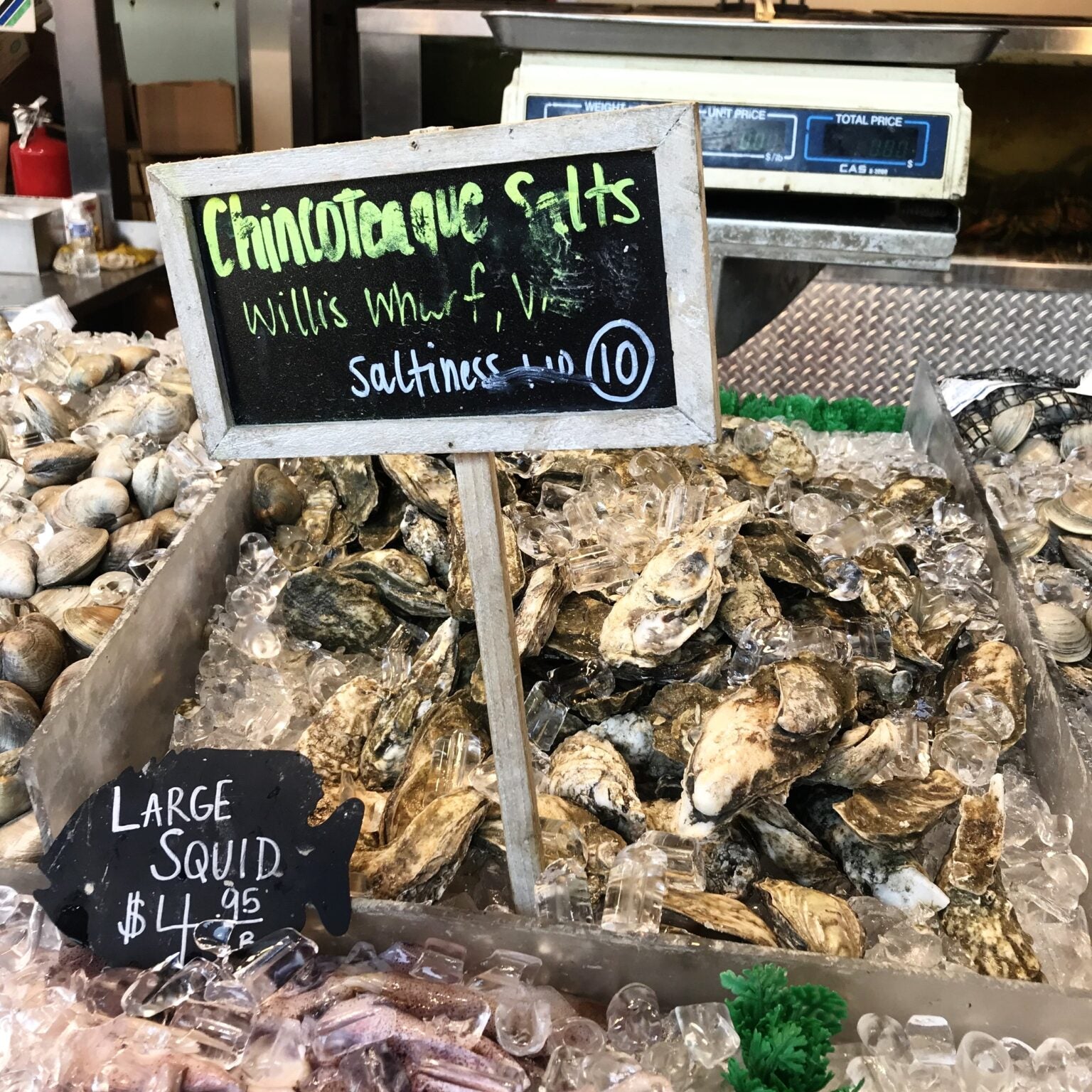The Story of Clammerhead and the Famous Green Gills

Here`s a scene for the books. Imagine four oyster-obsessed people at midnight in a Cambridge parking car garage, huddled over 1,000 oysters chilling in the trunk of a red Hyundai. Like diehards shivering for a fix, we anxiously awaited each shuck, slurped them down and zipped a few shells across the lot, back to the natural wild from whence they came. As they ricocheted off the pavement and echoed through the garage, we chuckled at the pure madness and martinis that led to this shivering moment (well, martinis for three out of four of us, that is). Welcome to Trunk Oyster Club (aka T.O.C.). Meet our guest shucker and oyster farmer for the evening, Clammerhead Cessna.
We met hours before at Les Sablons in Cambridge, and in fact, a couple days before that at the Seafood Expo in Boston. Clammerhead could have been the most animated character in the convention center; a North Carolinian Native, commercial fisherman and co-founder of Sandbar Oyster Company. He’s got the salt, the grit, the southern saunter, and you can tell he plays by his own rules. His featured oysters, the Atlantic Emerald green gills, were making waves and it’s no surprise. They are one-of-a-kind, just like the grower.
After Boston’s shenanigans, it was time to sit down for a real story. The Sandbar Oyster Co.’s presence has been gaining a lot of traction and showing no sign of stopping. They’re popping up around the country, both in restaurants, bars, and Instagram “shellfies” alike.
But it’s not just the traction of their green gill oysters that deserves a story. Who was this spirited, ungoverned, oyster-loving man of the sea, Clammerhead? How did his life as a rogue adventurer lead to two scientists, frequent use of the word “fluffy”, and a “New River Highway” of oysters?
Without further ado, let me introduce you to Clammerhead, and the famous North Carolina Green Gills.
Virginia: Some of my favorite memories are paired with eating oysters, from shucks with my grandfather as a child to Huitrerie Regis in Paris as a young traveler.
Clammerhead: Yes. I found that people with food – living that experience, they relate back to some of their childhood memories, or some of their family’s memories. And with oysters if you tie in a particular area, it makes a huge difference. The Green Gill is grown in a pretty centralized area on the coast of North Carolina. Many people remember things like Kitty Hawk and all the wild ponies on the Outer Banks. They just tie that memory back to when they were kids and would go to the beach. They get to relive a little bit.
Virginia: So, where did this all start for you? How did you fall into a life of oysters?
Clammerhead: Well, I got to the point where I just got tired of running from it and started to embrace it. Haha! Well, that isn’t entirely true…
My grandfather was born a commercial fisherman in North Carolina and he pretty much raised me. Granddaddy was the one I hung around with and eventually started a work life with. We are on the inland side of the Outer Banks area of North Carolina. Now, this area was actually settled by whalers from Gloucester way back. Black Beard’s ship, the Queen Anne’s Revenge, was found out of our main inlet near Beaufort. The place has got a lot of heritage and I was raised believing in that heritage.
I traveled off and on, and worked a lot of different places, but always came back home. Not sure why, but I loved the place. The majority of travel was from here down to Florida and over to Texas, following the fish. Scallops, shark fishing, tuna and shrimp fishing, swordfish… We traveled around, I was single, young, and in good shape. The world was peaceful; I could take off with a pair of flip flops, no shirt and a little suitcase, leave the state in a raging hurricane and drive across the America. Sometimes I’d go somewhere for no particular reason, get in a car and end up in Alabama, taste testing cheeseburgers for a few weeks. Evidently, we made too much money back then!
Being raised in the water, I’ve always been into shellfish, in particular clams because I was good at it and could roll a lot of change that way. When you’re a seven-year-old boy and want to make a little bit of money, all you need is a bucket and a rake. It’s a pretty cool situation.
I got dependent on my independence, and working when I wanted to. I owned construction, cleaning, and errand companies. I floated between contracts, and got back into the water when I wanted to.
V: Tell me where you got the name, Clammerhead, which is now your official alias.
Clammerhead: So here’s how I got my name Clammerhead. When we had periods of little or no rainfall, the water quality would get up so good in some areas that are normally closed, but really great for shell fishing. They’d officially open it up until it rained again. It’s called a “Special Opening”.
On one of those days, you’ll catch about 5-6,000 clams a day as opposed to somebody normally catching about 1,000. You could knock down a month’s wages in 3-4 days. When there’s a Special Opening in this one area, Davis Bay, everybody that doesn’t have to be to work goes and rolls some serious bank.
In 1990 I was working for a man named Charles Tyler building houses, and his lead man, Curly Whealton. I called Charles and left a message one day that there was a Special Opening in Davis Bay. We had a special agreement about these kind of days and Charles understood. So, I didn’t come into work, but Charles didn’t get the message I left, so they were at the job site talking about where I was at. As they were figuring it out, they were making jokes that I was out swimming with the Hammerheads, the sharks. It’s been known that I don’t get scared by sharks.
Charles said “Yep, I guess when he comes back we’ll call him Hammerhead.” Curly said, “No, call him Clammerhead.”
They created a rap song, wrote it on all the walls, drawings… After the Special Opening closed days later and I went back to the jobsite, I took one look and saw a picture drawn of me with “Clammerhead” written below it.
When they started with the nickname I said to myself, I am not one to be owned. Right now, I’ve either got to succumb to putting up with it for the rest of my life, or I’ve got to own it. So I took it and ran with it. I’ve been published under that name, business cards, bumper stickers, the Clammerhead movie at fulltimeoyster.com – the whole nine yards. Even the companies I had were under The Clammerhead Group.
V: And how did things evolve to where you are today?
Clammerhead: Charles Tyler’s son, Adam Tyler, came out of the Navy, he’s about 10-11 years younger than me and needed a clamming partner. We worked together off and on for 20 years or so and we were good friends. He happened to be somehow kin to Dr. Joel Fodrie, who asked Adam for two commercial fisherman to work for a Sea Grant project, with decent pay, and if he knows of a real animated man named Clammerhead. We investigated each other, and all looked good. He brought us in on the project, and it was Joel that introduced me to Dr. Niels Lindquist, my business partner, and CEO – Co-founder at Sandbar Oyster Co.
They are great guys to work with – not what you expect scientists to be like.
V; Ha, how so?
Clammerhead: They’re so down to earth – Joel was raised in this area and Niels was a surfer boy from Florida. We could all talk to each other. They took what we were saying with great respect.
Niels and I could speak the jargon and just go back and forth really. We had lots of ideas and were looking at it from two points of views – the scientific side and 50 years of working on the water. There were a lot of things we could do to figure out what was going on with oysters. What was killing them? How do we fix it? After about 6 years of working together, we invented a substrate where we could gather oyster larvae in areas it was plentiful and carry it and assemble those pieces that have spat on it to build reefs in areas where there wasn’t any. That’s just one basis of it. We were looking on what was causing the decline, and what we could do to turn the tide. We began working with inter-tidal sand shoals. There isn’t any aspect of it now that we aren’t looking into at some level.
V: Due to the high popularity of your area for vacationers, do you see any increases to those interested in tours?
Clammerhead: Agritourism and ecotourism are beginning to take off around here. Currently, we have two leases in the Newport River that total up to about 7 acres. We’ve got a ton of oysters out there. These are inter-tidal leases, so on about 20-30% of the tides, people can actually come out, walk around and look. We partnered up with Seavisions Charters and we use our shellfish leases where we can give tours on the oyster garden. We allow people to bring their own knives, so they can walk along eat at their own risk. They can pick up oysters and eat them, we just can’t allow them to carry them off. But it’s part of the tour and pretty hands on. I go out there and sing and dance a little bit.
(Virginia laughs.)
You laugh at me saying that, but I actually sing to our oysters. Do you think it really helps? I mean, you’ve had them. You tell me – is it the singing or is it not? I’ve heard myself sing so I doubt it is… It might just be some reverse psychology stuff freaking them out to where they’re like, “dude shut up, we’ll get fat, OK?”
The tourism is something that’s being fostered by the North Carolina Department of Agriculture. They’ve actually just opened up an agritourism grant for matching spending in a variety of ways for costs and advertising. They’re beginning to want to promote this. At the Beaufort Wine and Food Festival, we had the Seavisions Oyster Tour, where we took out a couple of reporters and guests to check out the sandbar. We stood out there and had oysters off the lease with a couple bottles of wine (I don’t drink but the others did!).
We’ve had a lot of press. We’re opening up new doors and we are hoping to keep that going.
V: What was your first impression when you cracked open an oyster for the first time that had green gills?
Clammerhead: That’s what I always thought an oyster was! Coming from a commercial fisherman family, when the Green Gill wouldn’t sell over the white ones, those were the oysters we ate. We knew there wasn’t anything wrong with them because that’s what granddaddy and his daddy ate. I had a dream since I was a little boy of creating a market for Green Gill oysters because we couldn’t sell them. He’d bust his back and try to sell them in hopes that he’d get at least a fraction of what he could get for white meat oysters. If we couldn’t sell them we would go shovel them back off the boat for when they whitened up, but that wouldn’t be for six months later.
V: As many of us know, you’re not the only ones with Green Gill oysters, and it’s highly desired in other parts of the world.
Clammerhead: France is the King of Green Gill. The French have been growing the algae in salt ponds (Fine De Claires), forever. They’ll move a white meat oyster in and have it turn green, usually takes 3-4 weeks, and they’ll sell it at a much higher rate. It’s not just a crafted oyster industry but crafted consumer service in France. Back in history it was a delicacy and you had to “be” somebody to get the Green Gills, a.k.a. “the oysters of the king.”
In North America it’s basically taboo to many people. Some people think it will kill you. There were rumors that the oysters turned green because they were feasting off dead bodies of soldiers or copper in the water. In fact, it was the opposite. The water was so clean, and there was plenty of food for a healthier oyster, it was actually a better product for the body.
V: Can you share more about the algae that makes a Green Gill?
Clammerhead: It’s basically a pretty simple biofunction. When the water turns clear and cold, and the sunlight can access the bottom, the other sea life that normally keeps the water stirred up are going dormant or have moved out – not stirring up bottom mud. So it gets really clear. The sun gets down into the water where this diatom (Haslea) is always present and allows it to grow. I think Niels just put something up about that diatom on the website. The oysters filter the diatom through their gills, and part of that diatom gets stuck in their gill.
The oysters are drawing from a cleaner source to begin with, and as the gills take on this diatom, the oysters take on the antioxidant, antiviral, and antibiotic properties of the diatom/algae.
It gives it a unique flavor as well. The flavor profile is dictated by water quality, what’s the food source, and the type of bottom. The flavor profile of the Atlantic Emerald is very salty, and fluffy. While fluffy might be hard to comprehend, once you have had one, you’ll agree.
V: Tell us more about your oysters, the ecology in the North River and surrounding areas.
Clammerhead: We grow on the bottom. We’re bottom growers. We have the Atlantic Emeralds, an all-natural diploid oyster in the North River. We have the American Jade in Core Sound, which is lower in salinity and a bit sweeter, crisper flavor. It doesn’t have the robustness, that fluffiness like the Atlantic Emerald, rather a more crisp and salty profile.
We have the AE MiniBars. They’re like the Atlantic Emeralds but smaller, and tumbled more. They have a heartier, thicker shell and deeper cup. In Newport River we have the Wild Ponies line. I picked that name from seeing the ponies on the Outer Banks. The larger ones are called Stallions, because, well, they’re bigger oysters. The smaller ones are called Colts, because they are a shooter oyster. That was my own little quip on that.
On the Harlowe Creek lease, we have the Sweet Loves, which has a buttery robust flavor. Everybody remembers that Sweet Love. We have oysters in the Bogue Sound, but haven’t yet figured out what to call them. I was thinking Beau Beauties but it’s not far enough off the screen.
We will have a white oyster out of North River in a few months. We have a lease in New River in the Jacksonville, NC area and I haven’t thought of what to call them yet. We won’t have those ready for another year, but I hope to have a story that makes them interesting. That’ll be a 3AM thought early in the morning.
We have a total of 8 leases in 5 water bodies, and we are planning to apply for more this year. We have leases ranging from a half to five acres. They aren’t big lease sites, but we have them in different sizes and areas for specific purposes. We don’t need a lease for more than what we are planning to use. A lot of it also has to deal with shoreline restoration.
V: Oyster Catcher Substrate. Can you share more about that?
Clammerhead: Oyster Catcher is a substrate comprised of plant-based fiber and mineral binders that was invented by my business partner, Niels, and myself. We infuse it and once it gets wet we design it in different shapes, to dry hardened in those shapes, like long rods or twisted up knots (“Rasta’s”). We have disks with a hole in it like a donut called “Patties”. We also use a mat form that are meter square blocks used for gathering seed and putting on a large oyster bed for growth.
“Tuffs” is basically a bunch of string that’s allowed to harden and used as a shell substitute for aquaculture. The “Lindquist Logs” resemble a great big blunt. Those are used in living shorelines for marsh banks where you would like to prevent erosion and give the grass and sand something to grow into. The patties are being used for restoration and living shorelines.
V: You have also been awarded a few grants and investments to build the “New River Highway of Oysters.”
Clammerhead: We petitioned the UNC Office of Technology and Development for a feasibility test. They gave us a grant to buy materials and since then we have run it for ourselves. We entered into the NC IDEA Entrepreneur Fund, got into the round we applied for, and made it to the finals where we were awarded one of the grants. They mentored us through the entire process and taught us a lot about structuring a business. We also received funds from the Kickstart program. Now, we are currently receiving funds from the city of Jacksonville, NC, for the “New River Highway of Oysters.” Basically, we’re going up into an area that will sustain oyster life, but has no, or little larvae delivery and we are building oyster reefs over a mile of the river. We’re building oyster reefs offshore for fish habitat, and brood stock, and to help the marsh line rebuild itself.
We have a lot of test projects going. Including ones in Florida, and the Puget Sound, as well as living shoreline projects in North Carolina.
V: So, when do you sleep?
Clammerhead: Sometimes I take a road trip, like going Boston, so I can sleep on the road.
(Virginia is laughing)
No really, I don’t sleep – I don’t want to sleep. I’m having too much fun. I love my job – it’s hard – but I love my job.
V: Would you like to share any places where we can find your oysters?
Clammerhead: Check out Shuckin’ Shack and Tres Hundertmark of NCOyster365. He had the idea of featuring them there. Rowan Jacobson coined the term “Napa Valley of Oysters” for North Carolina oysters, which caught on, and later featured the Atlantic Emerald in Tasting Table, and his latest oyster book – The Essential Oyster. They are at Coastal Provisions in Kitty Hawk, North Carolina. Another place is the Carolina Inn Crossroads in Chapel Hill. Mother Earth Seafood in Ashville NC has them, too. We’ve served them in Charleston and the Miami Beach Botanical Gardens. Locals Seafood in Raleigh NC retails them as well.
Going to Boston was our first big breakout in traveling and it was a success. Samuels and Sons in Philadelphia put in for a big order. We just sent some out to Ohio which was another order originating out of Boston. We served them at Les Sablons out of Cambridge Massachusetts – that event had all 5 species of oysters on that menu. We held our own on that menu!
Next year we’ll probably be in Boston with two different oysters and a good setup with the Oyster Catcher substrate. We want to try to get a lot of plastics and pollution out of the water and grow reefs that mimic natural reefs.
Virginia: Which ultimately leads to a better environment for us all. We will see you in Boston, Clammerhead. Thank you so much for sharing more with us, and we can’t wait to see what next year brings.
You can follow the Sandbar Oyster Company on their Facebook page and get in touch with them through their website.
A special thanks to Megan Dohm from Thistle and Sun Photography for the cover photo and various photographic additions that captured Clammerhead’s character so well.
For those of you who love sunsets, check out the following amazing photos Clammerhead has captured on the North River:






























